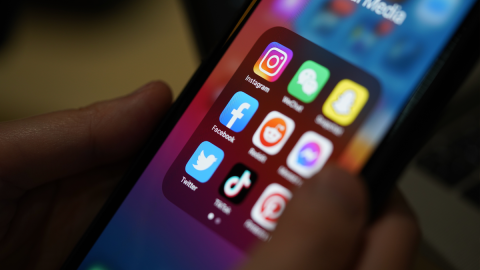There are 4.8 billion social media users worldwide (2024). WhatsApp, YouTube, Facebook and Facebook Messenger, Instagram, X (formerly Twitter), and TikTok are the most used social media platforms in the UK (2023 data). They all have a broad professional usership, as does the business-specific LinkedIn.
Physiotherapy features across all of these networks, in addition to the CSP’s own interactive CSP (iCSP) community.
Before you get started:
- Check with your employer about their policy for use.
- Check your privacy preferences if you set up an account and adjust as needed.
The pros and cons of certain social media platforms
WhatsApp (or WhatsApp Messenger) is a messaging service.
Pros
- Simple to connect with anyone in your phone’s contact list.
- Strong security, with messages fully encrypted between users.
Cons
- Encryption and closed groups can lead to a false sense of security – you still need to stick to all the standard rules about confidentiality, data privacy and consent (see the ‘professionalism on social media’ section in this guide).
Useful for: group messaging and helping ensure messages are secure.
View the WhatsApp FAQs for further information.
YouTube
YouTube is a video-sharing platform.
Pros
- Enormous audience worldwide and a huge resource of existing content.
- High engagement with videos from your viewers compared to other networks.
Cons
- Creating video content requires more effort than other types of posts.
- Typically takes longer than other networks to build a dedicated follower base.
Useful for: Building a home for videos that promote physiotherapy and for sharing learning.
View the YouTube support section for guidance.
Facebook is a networking service.
Pros
- Massive user base in the UK, although much smaller for professional matters.
- Allows you to set up closed groups for private discussions or a business page for promoting your practice.
Cons
- Relative complexity of setting up a business page.
- No guarantee that your posts will be shown to your followers – Facebook filters users’ news feeds.
Useful for: Reaching the public and creating private groups.
View the Facebook support page for help creating an account and any queries.
You can set up a Facebook page for your business and need a Facebook account to link this to.
Facebook Messenger is also available for Facebook users. Facebook has guidance on how to set this up and it will be linked to your Facebook account, which you need to set up first.
Instagram is a photo and video sharing service.
Pros
- The visual basis of posts makes for a rich user experience.
- Engagement with Instagram posts is much higher than with Facebook or X (formerly Twitter).
Cons
- Difficult to place links to other online resources.
- Posts have to be photo or video-based so require more creative input.
Useful for: Building a strong image of what you or your business is about.
View the Instagram help area for information.
X (formerly Twitter)
X (formerly named Twitter) is a networking service.
Pros
- Large, active physiotherapy and trade union communities on X (formerly Twitter) in the UK and beyond. Popular with politicians, healthcare decision-makers and other influencers.
- Simplicity and speed of posting.
- Following and list features allows you to control whose posts you see.
Cons
- Messages on free accounts are limited to 280 characters (though many see this as a benefit).
- Unmoderated – some users are trolls, and others post negatively due to the ease of posting now and thinking later. There are many automated (non-human) bot accounts.
- Unmoderated – some users are trolls, and others post negatively due to the ease of posting now and thinking later. There are many automated (non-human) bot accounts.
- 'For you' feature may show content you find offensive.
Useful for: Live debate, building influential relationships and following the latest news and events.
View the X (formerly Twitter) help guide for information.
TikTok
TikTok is a video sharing platform.
Pros
- Huge audience worldwide and a wide range of existing content.
- High engagement with videos from your viewers compared to other platforms.
Cons
- Creating video content requires significant effort but the format is less polished than YouTube.
- Range and quality of content differ massively.
Useful for: Promoting physiotherapy, your practice and sharing learning.
View the TikTok support section for information.
LinkedIn is a business and employment-focused platform.
Pros
- Large professional networking base, widely used for showing expertise to prospective employers and clients.
- Allows you to set up closed groups for private discussions.
- The articles feature allows easy blogging.
Cons
- Less real-time interaction than the other main social networks.
- Regular contact from people trying to sell you business services.
Useful for: Building an online CV and a network of professional contacts, professional blogging and advertising jobs to your network.
View the LinkedIn help guide for information.
Bluesky
Bluesky is a networking service.
Pros
- Simplicity and speed of posting.
- Good moderation rules on offensive content.
- The starter pack feature allows you to invite contacts to follow you.
- Customised following features that allow you to focus on what you see.
Cons
- Small community.
- Messages are limited to 300 characters (though many see this as a benefit).
Useful for: building relationships with some people migrating from X (Twitter).
View the Bluesky help guide for information.
Interactive CSP (iCSP)
Interactive CSP (iCSP) is the Chartered Society of Physiotherapy (CSP) online physiotherapy network service, with each network based around a specific issue, interest, specialty, or work-related role.
If you already have a CSP website account, you just need to set up your iCSP preferences. (If you need to set up an account first, follow the instructions on the Registration page.)
Log in and look for the link to ‘Your networks’. Select the ‘All other networks’ tick box option to see a list of all the networks available to you. Join any that look interesting – you can choose whether to receive emails from them at this point too.
Quick access to iCSP on your phone
Next time you log in to the CSP website, choose the ‘keep me logged in’ option. Then go to iCSP and save the page as a home screen button on your phone. You’ll then have a one-touch link to the latest content from all of your networks you’ve joined.
Pros
- Physio-specific, CSP member-only community, aligned with professional and reps’ networks.
- Holds a large, searchable archive of shared knowledge and information.
Cons
- Can’t extend discussions to non-CSP members.
- Responses to discussions tend to take longer than X (formerly Twitter) and Facebook.
Useful for: Member-only discussions, sharing and building a knowledge base.
View the iCSP community rules and the iCSP terms of service before you get started.
How to increase your followers
Look at other people’s lists of followers to get ideas to extend your own list. Once you’ve started following a few people, your timeline will fill up quickly. Make sure to check regularly to see what the people you follow are saying.
Getting more tailored content
Follow topics and themes – if you’ve found something interesting through a search, follow the author for more on that subject. Many events pre-publicise a hashtag (e.g. #physio24), encouraging delegates to tag their posts accordingly before, during and after the event to raise its profile. You can then follow what’s going on by viewing a live list of posts that contain that tag.
CSP social media accounts
Follow the CSP social media accounts to help get you started:
- X (formerly Twitter): @theCSP
- Facebook: /charteredphysios
- YouTube: Chartered Society of Physiotherapy
- LinkedIn: The Chartered Society of Physiotherapy
You can also visit the Nationals and Regions pages for details about social media accounts in your area.



